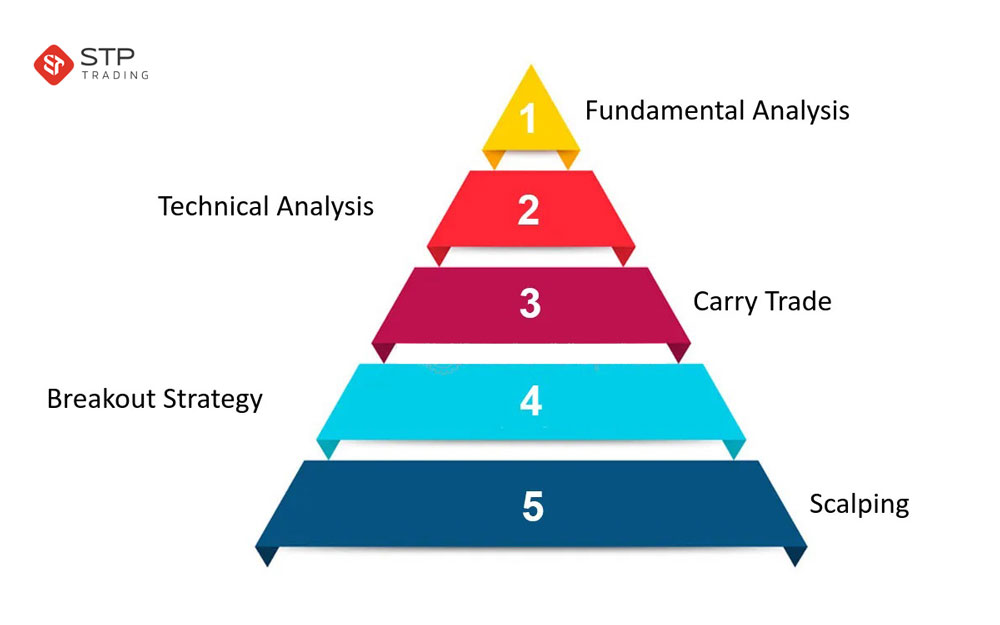
Forex trading strategy is a set of rules and methods presented by traders in the currency market to execute successful trades. The primary goal of these strategies is to reduce risk and increase trading profits. Two main types of analysis are commonly used in forex trading strategies: technical analysis and fundamental analysis.
Technical analysis is performed based on analyzing price charts and technical indicators such as support and resistance levels, new high indicators, and moving averages. Traders using this approach make decisions for entering and exiting trades based on chart patterns like candlestick patterns and price measurement patterns. Fundamental analysis is conducted by analyzing economic and political information such as interest rates, inflation rates, employment conditions, and other fundamental factors. Traders using this approach make trading decisions based on the analysis of these factors.
To increase profits in the forex market, traders can utilize various strategies such as scalping strategies and combination strategies. Each of these strategies has its own advantages and disadvantages, and their usability depends on market conditions and the trader’s style.
Before applying any advanced strategy, ensure you understand the basics of margin in forex to avoid common pitfalls and enhance your performance.

What is a Trading Strategy?
A trading strategy refers to a set of rules and methods presented by traders for executing successful transactions in financial and investment markets. These strategies are usually based on technical analysis or fundamental analysis, and their goal is to reduce risk and increase trading profits.
Trading strategies can be implemented systematically or non-systematically. In systematic trading, transactions are executed based on a specific set of rules, often automated, while in non-systematic trading, transactions are based on personal analysis and trader experience.
There are diverse trading strategies, including daily strategies, scalping strategies, momentum trading, and combination strategies. Each of these strategies has its own specific advantages and disadvantages and is used based on market conditions and the trader’s style.
Looking for more details? These articles provide additional perspectives:
What Are Fibonacci Retracement Levels?

Finding an Appropriate Forex Trading Strategy Solution
There are various strategies for use in the forex market, and selecting the best strategy depends on the current conditions and the ethical characteristics of the trader.
Only a very small number of traders find the best forex strategy from the beginning; the right strategy that suits their personality. Most individuals experiment with different strategies in demo and trial accounts to ultimately arrive at a suitable forex trading strategy that yields desired profits.
Sometimes you might offer an excellent strategy that yields good results and seems better than any other strategy, but it’s unlikely you’ll stick with it for an extended period. Nevertheless, financial markets are constantly changing, and as a forex trader, you need to adapt to them.
If you’re an inexperienced trader in the forex market, it’s better to start with simple and uncomplicated strategies. Most novice traders make significant mistakes. They employ various technical indicators and tools in their strategy, which only leads to information overload on charts and eventual confusion.
Therefore, the best approach to selecting a profitable forex strategy might involve starting with simple strategies and adjusting them according to your needs and experiences that you acquire.
One way to enhance your trading strategies is by understanding the difference between Market Profile vs. Volume Profile.

Selecting the best trading strategy depends on experience, market conditions, and the trader’s style. In the forex market, some common trading strategies include:
Technical Analysis Strategy:
This strategy relies on analyzing charts and technical indicators such as support and resistance levels, moving averages, and relative strength indicators.
Fundamental Analysis Strategy:
This approach is based on analyzing economic and news information such as interest rates, inflation rates, employment conditions, and global market trends.
Scalping Strategy:
This strategy involves short-term trading to profit from small price differences between buying and selling in a short period.
Combination Strategy:
This strategy combines technical and fundamental analysis to create a comprehensive approach to trading in the forex market.
Ultimately, a combination of factors, including market conditions, personal preferences, and the trader’s level of expertise, will determine the most effective trading strategy.
To maximize the effectiveness of top Forex trading strategies, add trendlines in Forex trading to help refine your entry and exit points.
Best trading strategies in technical analysis
Each trading strategy in technical analysis has its own advantages and disadvantages based on market conditions and the trader’s style. It may be suitable or not depending on the circumstances. Below, we’ll mention some of the best trading strategies in technical analysis:
Price Patterns
This strategy is based on identifying price patterns such as candlestick patterns. Using these patterns, traders can predict market reactions and consequently execute successful trades.
Moving Averages
This strategy is based on moving averages. By using this method, traders can predict market trends and enter or exit positions at appropriate intervals.
Support and Resistance Levels
By identifying support and resistance levels on price charts, traders can predict market reactions and execute successful trades.
Technical Indicators
Technical indicators like the Relative Strength Index (RSI), Average Directional Index (ADX), and Bollinger Bands can also be used as trading strategies in technical analysis.
Breakout Strategy
In this strategy, traders look for breaking a support or resistance level on the chart. This strategy is particularly effective in markets with strong volatility, such as the forex market.
Trend Strategy
In this strategy, traders identify market trends and trade in the direction of those trends. This strategy is usually effective in markets that are currently moving in one direction, such as bullish or bearish markets.
A key element in Forex trading strategies is adjusting lot sizes to your risk profile. Learn more about what lots in Forex are and how to calculate them.
Bear Trap Trading Strategy in Forex

Trendline Strategy
In this strategy, traders use the moving average indicator to identify market trends and trade accordingly. This strategy is effective in markets that are currently moving in one direction, such as bullish or bearish markets.
Price Action Strategy
“Price Action” is a type of trading strategy in which buying and selling decisions for an asset are made based on the type of price movement it exhibits. In Price Action, there is no reliance on technical analysis indicators such as RSI and MACD, and everything depends on how the price moves on the chart.
The Price Action strategy itself is divided into several types. One of the main advantages of the Price Action strategy is that the chart in front of you is always simple and free from colorful technical analysis indicators. This prevents inexperienced traders from getting overwhelmed by information overload.
In a Price Action strategy, traders focus on reading the raw price movement, identifying patterns, and making trading decisions based on the price’s behavior, such as candlestick patterns, support and resistance levels, and trend lines. This approach is often favored by traders who value simplicity and want to directly interpret market dynamics from the price movements themselves.
Range Trading Strategy
Range trading is another forex trading strategy that is employed when the price of a currency pair is confined within a specific range. Depending on your trading timeframe, this range can span from 20 pips to several hundred pips. In this strategy, we require strong and stable support and resistance levels that have repeatedly prevented the currency pair’s price from breaking out.
Traders utilizing the range trading strategy should seek currency pairs that are currently lacking a clear trend. To do this, you can simply observe the price movement of the asset in question or use technical analysis indicators such as moving averages for assistance. Once you’ve chosen a currency pair or any other asset without a clear trend, you should identify the range in which the price is currently confined. Subsequently, you can opt to sell at resistance levels and buy at support levels.
It’s worth noting that different trading strategies within technical analysis are determined based on the trader’s style and market conditions. Therefore, to choose the best trading strategy, traders should be familiar with market conditions and have knowledge about various technical analysis methods.
Trading During News Releases
The news trading strategy is used during significant news releases, like inflation rate announcements or other economic data releases. Traders aim to capitalize on the volatility that occurs during such events. Trading during news releases is a high-risk and volatile strategy that can even increase the spread. For this reason, your transactions may be executed in greater or lesser numbers than expected, leading to varying outcomes.
Once you’ve identified your preferred strategy, the 5-3-1 Rule in Forex helps you narrow your focus and build a routine that avoids overtrading.

What is Daily Trading strategy?
The daily trading strategy is one of the most common trading strategies in the capital markets. Trades are executed during a single day, and all positions are closed by the end of the day. Traders analyze price charts in the morning to determine buying or selling positions and hold those positions until the end of the day. In this strategy, traders typically seek short-term profits and strive to achieve significant gains within a single day.
Due to the short-term nature of the trades and the lack of need to hold positions for the following days, the day trading strategy is suitable for traders who are looking for short-term profits. Additionally, this strategy is the best approach for traders aiming to reduce risk and invest in short-term intervals.
Day trading strategy relies on technical analysis and price chart examination, making it suitable for traders with experience and sufficient education in this field. To utilize this strategy, traders must focus on identifying price patterns and analytical levels such as support and resistance points, candlestick patterns, and technical indicators. For successful transactions within this strategy, traders need to adhere strictly to risk management rules. Given the high risk associated with this strategy, traders must implement an appropriate risk management system.
Behind every great trading strategy is solid market analysis. Discover how the 3 types of analysis in Forex support and shape each strategic decision.

Conclusion
Forex trading strategies consist of a set of rules and regulations that help traders identify entry and exit points. There are various strategies available, including daily trading, scalping, and more. Please note that in addition to strategies such as daily trading, scalping, etc., which we discussed in this article, there are other Forex strategies such as swing trading strategy. Your choice of strategy depends on your personality, skills, and current conditions. For instance, if you’re comfortable with numbers, can handle the stress of quick trades, and have a good understanding of the markets, strategies like daily trading and scalping might be suitable for you.
Stay ahead by exploring the future of forex trading alongside these top strategies.






